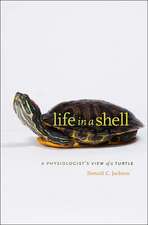New Developments in Marine Biotechnology
Editat de Y. Le Gal, H.O. Halvorsonen Limba Engleză Hardback – 29 iun 1998
| Toate formatele și edițiile | Preț | Express |
|---|---|---|
| Paperback (1) | 1223.88 lei 6-8 săpt. | |
| Springer Us – 30 noi 2010 | 1223.88 lei 6-8 săpt. | |
| Hardback (1) | 1231.64 lei 6-8 săpt. | |
| Springer Us – 29 iun 1998 | 1231.64 lei 6-8 săpt. |
Preț: 1231.64 lei
Preț vechi: 1501.99 lei
-18% Nou
Puncte Express: 1847
Preț estimativ în valută:
235.67€ • 256.80$ • 198.59£
235.67€ • 256.80$ • 198.59£
Carte tipărită la comandă
Livrare economică 23 aprilie-07 mai
Preluare comenzi: 021 569.72.76
Specificații
ISBN-13: 9780306459078
ISBN-10: 0306459078
Pagini: 343
Ilustrații: XVI, 343 p. 39 illus.
Dimensiuni: 178 x 254 x 21 mm
Greutate: 0.84 kg
Ediția:1998
Editura: Springer Us
Colecția Springer
Locul publicării:New York, NY, United States
ISBN-10: 0306459078
Pagini: 343
Ilustrații: XVI, 343 p. 39 illus.
Dimensiuni: 178 x 254 x 21 mm
Greutate: 0.84 kg
Ediția:1998
Editura: Springer Us
Colecția Springer
Locul publicării:New York, NY, United States
Public țintă
ResearchDescriere
Past efforts to colonize the environment and domesticate living species, coupled with scientific research, have resulted in the possession (but not always the real control) by humans of any available terrestrial space. However, oceans, which represent up to two thirds of the surface of the planet, had not been really approached until the middle of this century. As oceanographic science develops, the picture of a rich, diverse, complex and also, in many respects, specific marine life, is coming into view. In a broad sense, marine biotechnologies can be understood as the various means or techniques of managing marine living systems for the benefit of mankind. The first goal we have is for marine life to provide biomass for food. However, today it is not certain that a significant increase of total world fisheries' catches will be possible in the future. There are several ways to address this. First, we need to generate better, more complete, or different uses of the biomass actually fished. This is mainly a matter of upgrading fish and fish wastes. Second, we need to artificially grow the living species. This falls within the scope of cell cultivation and of aquaculture. Both approaches have to be appreciated si multaneously in terms of biology, ecology, and economy. In both approaches, profit improvements are linked to the introduction of biotechnological methods and to the use of biotechnological processes.
Cuprins
Biotechnology: Biology or Technology? Keynote Lecture; A. Kornberg. Molecular Biology and Transgenic Animals: The Paradox of Growth Acceleration in Fish; J. de La Fuente et al. Natural Products and Processes: A Novel Antioxidant Derived from Seaweed; W.C. Dunlap, et al. Aquaculture: The Development and Commercialization of Tetraploid Technology for Oysters; S.K. Allen, Jr., X. Guo. Develomental Biology: Expression of Thyroid Hormone Receptor-alpha in the Growth and Development of the Sea Bream (Sparus Aurata); L. Llewellyn, et al. Biology of Cell Factories: North American Porphyra Cultivation: From Molecules to Markets; I.A. Levine, D. Cheney. Bioremediation, Extremophiles, and Host-pathogen Interactions: The Architecture of Degradative Complex Polysaccharide Enzyme Arrays in a Marine Bacterium Has Implications for Bioremediation; R. Weiner, et al. Biodiversity, Environmental Adaptation, and Evolution: Intron as a Source of Genetic Polymorphism for Fish Population Genetics; S. Chow. Biomarkers, Symbiosis, and Viruses: Mannose Adhesin-Glycan Interactions in the Euprymna Scolopes-Vibrio Fischeri Symbiosis; M. McFall-Ngai, et al. Workshop: Workshop on Biodiversity: Synthetic Report; J.F. Grassle, J.B.L. Matthews. 59 Additional Chapters. Index.
Recenzii
`The book is a must for all practitioners of marine (and freshwater) biotechnology, as a compendium of what is becoming possible, and of the remaining obstacles on the road to an environmentally acceptable exponential growth in the exploitation of marine resources for the production of safe products. ... the book is of great interest to practitioners of biotechnology in any other domain, microbial, agricultural, and animal.'
Journal of Experimental Marine Biology and Ecology, 246 (2000)
Journal of Experimental Marine Biology and Ecology, 246 (2000)













